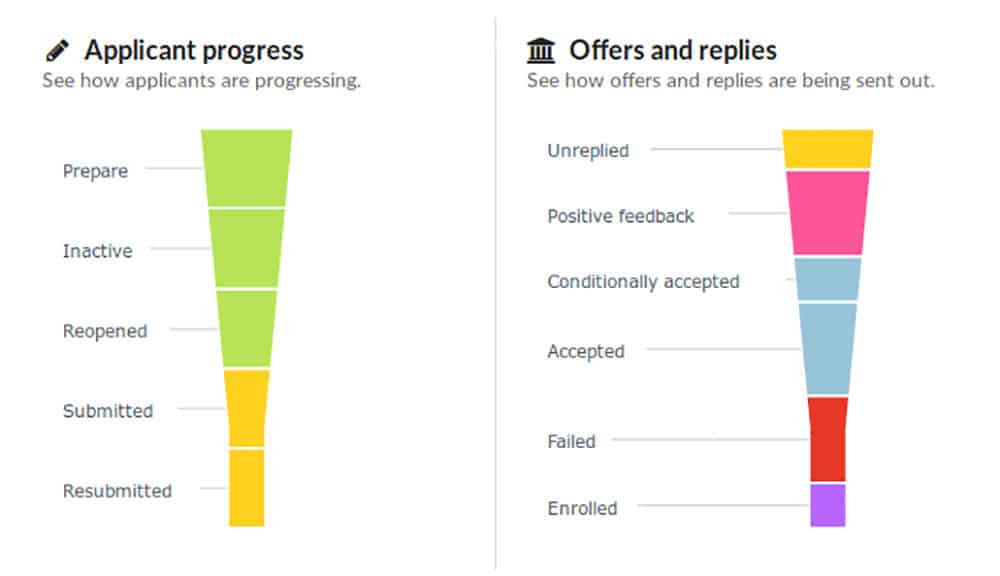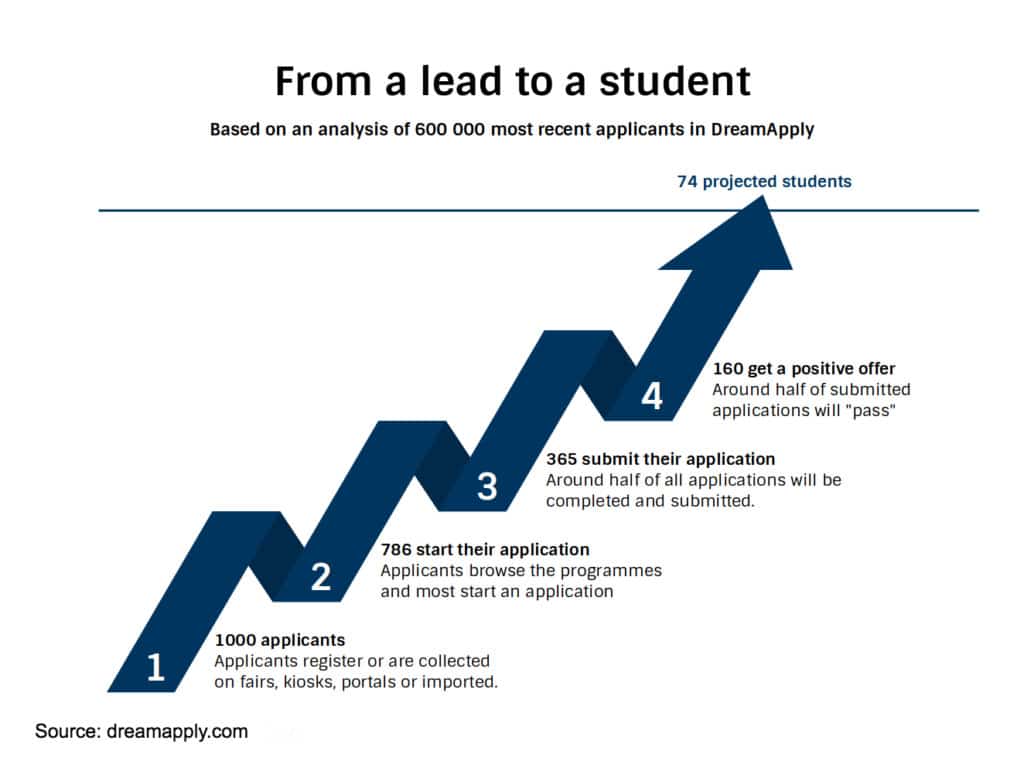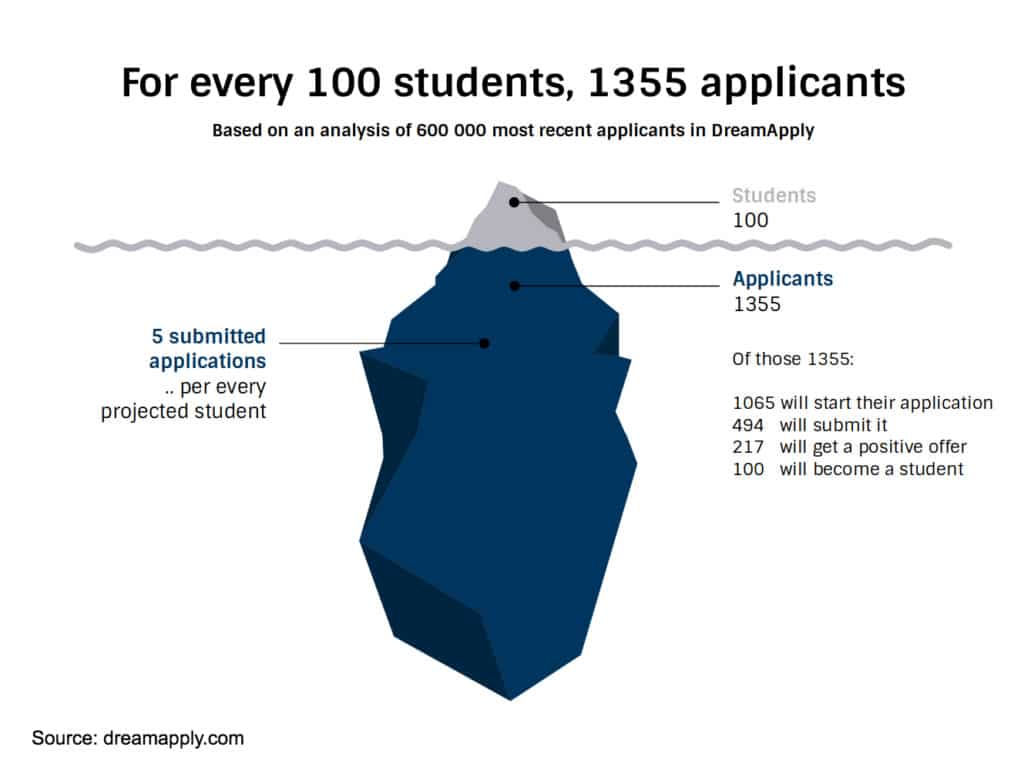Can you guess how many applications it takes to find a new student? The short answer seems to be 5, if your admission tools can only count submitted applications. Or maybe 10 if you have a deeper view into the process. Before we examine why this is the case, here’s a brief background on how we obtained this data.
How did we get our data?
DreamApply offers a student admission platform for hundreds of universities across the world, giving us a unique perspective to see how many applicants are gained or lost at every step of the admission process.
DreamApply starts tracking the progress of applicants from the moment that they become an interested lead. Our customers will see how their applicants progress from completing and saving each section of the application form, up to successfully submitting their documents.
After this step, applications will be assigned a progression of statuses as they get handed down from the admission department to the heads of departments, professors, examination boards and other stakeholders.

Ultimately, some lucky applicants will receive a positive offer, which they are expected to accept or decline within a set deadline.
As alluded above, while each of our customers utilize unique process flows, an analysis of the overall aggregates can still provide an interesting benchmark. DreamApply users of course already have deeper insight into their own numbers.
Here are the numbers!
The statistics below are based on a set of around 600 thousand of the most recent applicants across all users of the DreamApply platform.

When you look at the data from the point of view of admitted students, a good visual analogue is an underwater iceberg:

Please scroll down for the raw data.
Conclusion
Here are our four, main takeaways:
First, as one can see, only about 7.4% of all leads will progress to a student.
This highlights the importance of properly targeting your marketing efforts in order to not weaken what are already thin margins of success.
DreamApply offers you not only a view of which marketing efforts brought in the most leads (this is the easy part), but also allows you to track them across the next steps as well, until they become a student.
Perhaps an AdWords campaign brought in a large number of clicks, but ultimately no students, while a fair in India that did not look promising at first, had a much higher success rate in terms of submitted applications and enrolled students. Every individual instance, as well as overview of user-specifiable groups, is accessible and measured.
Second, for every 100 applicants that start their application, only 46 will go on to complete and submit it.
If your student admission solution does not offer you visibility into “in progress” applications before they are finally submitted (or worse yet, does not allow applicants to save their progress!), your numbers are likely much lower than that.
Applicants that fail to make headway in DreamApply are automatically assigned an “Inactive” status, offering our users the possibility to follow up with support or encouragement.
Third, the numbers that we all measure in the field. Of all submitted applications, we see that on average, across all of our users, 44% will receive what can be categorized as a positive offer.
What makes up a positive response varies across universities (some universities make conditional offers, for example), but it is generally understood to be a status where the applicant has been offered a place of study, leaving only technicalities to be solved.
Going through the rest of the 56% of applications efficiently, objectively and in a timely manner, constitutes probably the biggest pain point in all admission departments. For DreamApply users, a lot of this process can be automated with mass rules, recorded video interviews, machine vision tools and most importantly – offering a user interface that does not get in your way!
Finally, less than half of the offers that are sent out are ultimately accepted by the applicants on their way to becoming a student.
If your result is greater than that – congratulations!
The reasons for losses at this stage are varied, but one of the main questions is – time! We see that the faster you are able to issue your offers, the better the success rate will be.
Stay tuned for another article that goes into more detail on this topic.
Where to go from here?
We intend to post follow-ups on these statistics in order to break down the data on region, country, lead source, destination country, gender, age and programme types. Subscribe below for updates.
Here is a look into some raw data:
Number of all applicants/leads:
639 749
Number of applicants that started filling in their application:
502 995
Number of applicants that completed and submitted their application:
233 387
Number of applicants that received a positive offer:
102 611
Number of applicants that accepted their offer:
47 222
About DreamApply
Founded in 2011 in Estonia, DreamApply is an innovation-driven EdTech organization improving access to education around the globe. DreamApply’s application management software helps more than 300 educational institutions across 40 countries improve admissions, marketing, scholarship management and other internal processes.
DreamApply’s easy-to-use and customizable software increases student enrollment by 30% and reduces application processing time by 40%. With features designed with and for educational institutions, and integrations with commonly used systems, DreamApply empowers teams to get more done with less effort.
Continue exploring by requesting your free, personalized demo.
Subscribe and be the first to receive new case studies, podcast episodes, blog articles and other EdTech resources.

